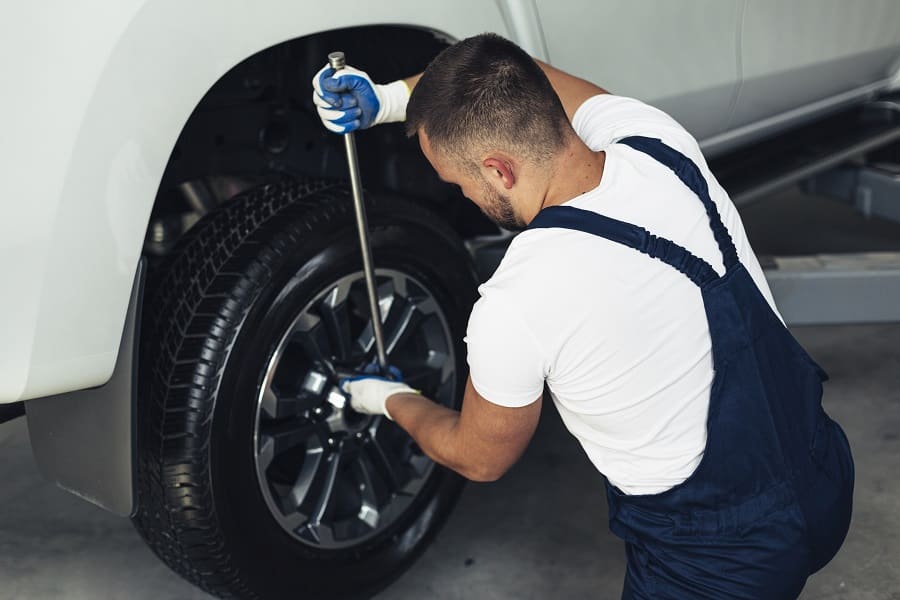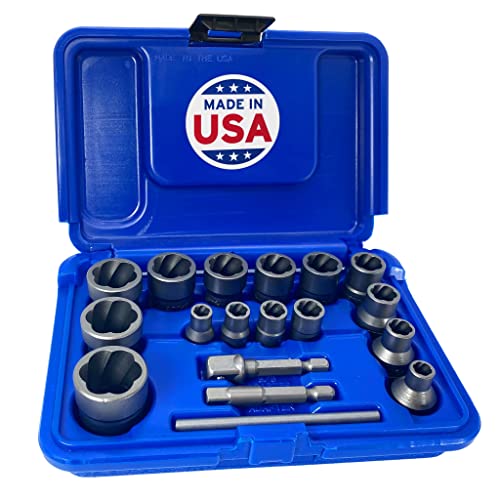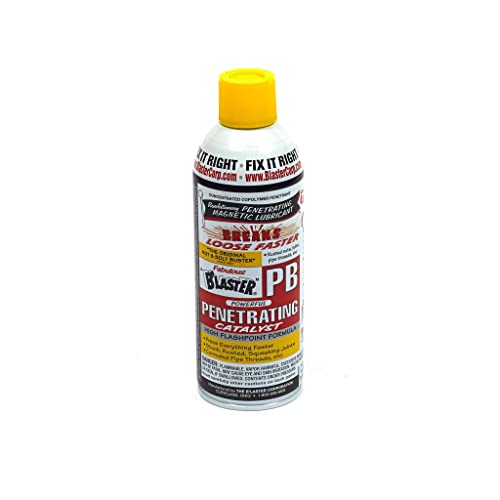Lug nut removers are a must-have tool for anyone who has to change a tire or perform other maintenance tasks on a vehicle wheel or hub. They can make the job much more accessible and save time and frustration compared to standard tools. (Below) you will see stubborn and traditional lug nut removal tools conveniently available online, and a few helpful techniques to remove stubborn lug nuts.
6 Essential Stubborn Lug Nut Removal Tools
Although removing stubborn lug nuts might be difficult, there are a few tools and techniques you can attempt; let’s go over the following six tools you may need as shown below:
1. Lug Nut Remover
The lug nut remover covers the nut and has a driving mechanism that may be twisted with a ratchet, wrench, or other tools to impart torque to the lug nut. Lug nut removers come in various sizes and shapes, tailor-made to fit different types of lug nuts. Typically, steel and rigid materials are used to make them.
Some lug nut removers are explicitly designed for use on damaged or rounded lug nuts that cannot be removed with a standard wrench. These specialized lug nut removers may use teeth or other mechanisms to grip the lug nut and apply sufficient torque to loosen it.
Related PDR tools to fix dents in cars
For more on PDR tools to fix dents in cars read the full article.
2. Breaker Bar
A breaker bar is a long-handled wrench that provides additional leverage to help loosen stubborn lug nuts by applying more significant pressure by mounting the bar on the end of the wrench.
3. Impact Wrench
An impact wrench successfully releases corroded or jammed lug nuts because it produces excellent torque in brief bursts. An impact wrench also decreases the physical effort and strain needed to remove stubborn lug nuts since it works fast and effectively. As a result, it is highly recommended to remove challenging lug nuts.
4. Torch
If nuts are rusted or seized, applying heat can help loosen them. You may use a propane torch to warm the lug nuts for a few minutes before loosening them. Be careful not to overheat the lug nuts or the surrounding area, as you may damage them.
5. Penetrating Oil
Spray penetrating oil such as WD-40 or PB-Blaster on the lug nuts and let it sit for several minutes to penetrate and loosen rust or corrosion. Avoid getting the oil in contact with the tire or brake disc, as it can slip and reduce traction.
6. Rubber Mallet
Gently tap the tire with a rubber mallet to help loosen any remaining rust or corrosion that may be jamming the lug nuts. Seek professional help: If you cannot remove difficult lug nuts, it might be time to call a qualified technician. They have specialized and experienced tools to help remove stubborn lug nuts without damaging the vehicle or wheel.
Related Jumper cables made in USA
For more on jumper cables made in USA read the full article.
Traditional Lug Nut Removal Tools
The purpose of a traditional lug nut wrench is to take lug nuts off of automobile wheels. It features a long handle and a socket that slides into the lug nut for leverage. There are several varieties of lug nut wrenches; let’s cover the two most common such as:
1. Cross Wrench
Also known as a lug wrench, the cross wrench. To suit a range of lug nut sizes, it often features four distinct socket sizes, one at each end of the cross shape. To use it, you need to position the proper socket size over it to tighten or loosen the lug nut and exert force by rotating the cross-wrench handle.
2. Telescoping Lug Nut Wrench
An adjustable telescoping handle on this type of wrench allows for greater leverage when required. It often has several sockets to accommodate various lug nut sizes. Following the manufacturer’s recommendations and using the proper safety gear is crucial while using any tool to remove lug nuts.
Related Bottle jack made in USA
For more on bottle jack made in USA read the full article.
Easiest Way to Remove Lug Nuts
Although the best method for removing lug nuts may vary depending on factors such as available tools and the specific situation, the following general steps can be followed:
- First, try loosening the nuts with a cross-lug nut wrench or impact wrench. Be sure to apply force counterclockwise (left direction) when using a wrench.
- Apply a penetrating oil, such as WD-40 or PB-Blaster, to the base of the nuts if they are difficult to remove or stubborn. Allow the oil to work for a few minutes before loosening the nuts.
- If the lug nuts are still stubborn, using heat with a propane torch can help stretch the metal and make the nuts easier to remove.
- Use the lug nut wrench to remove the nuts once they are free. Keep the lug nuts and studs clean and dirt-free to ensure proper and secure tightening.
- When reassembling the wheel back to your vehicle, tighten the nuts to the required torque using a torque wrench. This standard is often accessible online or in the owner’s manual. It is important to note that over or under-tightening the lug nuts can damage the wheel studs and jeopardize safety.
For more on should you double click a toque wrench read the full article.
Will WD-40 Help Remove Lug Nuts?
WD-40 can be useful in helping to remove lug nuts, especially if they are rusted or corroded. It is a penetrating oil that can help loosen rust and corrosion, making it easier to remove the lug nuts. Here are the procedures for removing lug nuts with the use of WD-40:
- Spray WD-40: Spray WD-40 to the base of each lug nut to penetrate the threads and release corrosion or rust. Wait for about 15 to 20 minutes for the WD-40 to penetrate. If the lug nuts are stubborn, waiting for many hours or even overnight can be required.
- Utilize a lug nut wrench or impact wrench: Make an effort to remove the lug nut using a lug wrench or impact wrench. Use a breaker bar for extra leverage if the lug nut is still difficult to remove.
- Repeat if necessary: Spray extra WD-40 at the base of each lug nut and set it for a few minutes before attempting to remove it again. If the lug nut is still difficult to remove, repeat the process.
- Wipe off extra WD-40: After removing the lug nut, use a clean cloth to remove any extra WD-40 from the wheel and lug nut.
Although WD-40 can be useful in removing obstinate lug nuts, it’s crucial to use caution and adhere to the correct safety standards when working on your car. Always ensure your vehicle is properly supported on jack stands or a lift before removing lug nuts.
Will PB-Blaster Help Remove Lug Nuts?
PB-Blaster is a penetrating oil designed to help loosen rusted and jammed parts. Therefore, especially if they have rusted or corroded over time, it can aid in removing lug nuts that are tough to remove.
The lubricant PB-Blaster penetrates the threads when applied to the base of the lug nuts and helps to loosen the binding between the nut and stud. This can make it easier to loosen the nut with a traditional lug nut wrench or impact wrench.
In contrast, it is necessary to note that the PB-Blaster may not work in all situations. Using excessive force or torque to remove the lug nuts may damage the wheel or vehicle. Therefore, it is important to exercise caution and follow proper safety protocols when using any tool or product to remove lug nuts. To remove lug nuts with the use of PB-Blaster, you can follow these steps:
- Park the vehicle on a level surface and apply the emergency brake.
- Spray a good amount of PB-Blaster at the base of each lug nut. Be sure to aim the nozzle at the area where the lug nut meets the wheel stud to allow the oil to penetrate the threads.
- Wait for the PB-Blaster to penetrate the threads and loosen the lug nuts. The time required may vary depending on the level of corrosion or rust on the nuts. Although waiting for at least 15 to 20 minutes is advised, if the lug nuts are stubborn, waiting for many hours or even overnight can be required.
- After waiting for the PB-Blaster’s effect, try loosening the lug nuts with a lug wrench or impact wrench. If the lug nuts do not loosen, apply more PB-Blaster and wait longer.
- Once the lug nuts have been adequately removed, thoroughly clean the studs and lug nuts to remove any PB-Blaster residue. This will prevent the residue from interfering with properly tightening the lug nuts during reassembly.
- Be sure to apply the required torque to the lug nuts when reassembling the wheel back to your vehicle to prevent it from falling off while driving.
What Is the Best Power Tool to Remove Lug Nuts?
The best power tool to remove lug nuts is an impact wrench. An impact wrench is a high-torque power tool that delivers a sudden burst of rotational force to help loosen bolts and nuts. Impact wrenches come in electric and pneumatic (air-powered) models, commonly used in automotive and construction applications.
For more on here’s why you need an impact wrench read the full article.
An impact wrench is an excellent option for lug nut removal since it can deliver the high torque required to rapidly and efficiently remove challenging lug nuts. In addition, an impact wrench can provide much more torque than a standard lug wrench or socket wrench, making removing lug nuts faster and easier.
Look for a model with a torque rating of at least 250 to 300 ft-lbs if you’re considering buying an impact wrench to remove lug nuts; this should be plenty for most automotive applications. Use the right size socket with the impact wrench to ensure a proper fit on the lug nuts.
Although removing lug nuts can be made simpler by using an impact wrench, it’s still crucial to use caution and adhere to the correct safety precautions when dealing with power equipment.
What Size Socket Do I Need For Lug Nuts?
You must consider the size of the lug nuts on your automobile to calculate the required socket size. The most typical lug nut sizes for vehicles and light trucks are typically 17mm, 19mm, and 21mm. You may either consult the owner’s manual for your car or look at the lug nuts to identify the required socket size. Here are some standard lug nut sizes and the corresponding socket sizes:
- 17mm lug nuts require a 17mm socket
- 19mm lug nuts require a 19mm socket
- 21mm lug nuts require a 21mm socket
To prevent damaging the lug nuts or the socket itself, it’s crucial to utilize the proper size socket. Suppose you need clarification on the socket size you need. In that case, it is advisable to reference your car’s owner’s manual or contact an experienced technician for guidance.
Note: In some vehicles, you might need to remove the plastic cover from each lug nut to get to the actual lug nut size.
For more on what sockets to use with a torque wrench read the full article.
How Do You Remove a Lug Nut Without a Lug Nut Key?
Removing a lug nut without a lug nut key can be challenging, but there are several options you can try, as follows:
- One approach is to use a socket set to find a socket that fits securely over the lug nut and then turn it with a ratchet or breaker bar counterclockwise (left direction).
- If the lug nut isn’t too tight, you may spin it counterclockwise (left direction) while gripping the edges with a pair of pliers.
- If the lug nut is exceptionally tight, tap a hammer and chisel on the lug nut’s edge to create a slight depression before turning the nut counterclockwise (left direction).
- Another option is a nut and bolt extractor, a specialized tool designed to remove stripped or damaged nuts and bolts. Place the extractor on the lug nut and use a wrench or socket to turn it counterclockwise (left direction).
Suppose the previously mentioned methods do not succeed. In that case, the safest approach is to acquire the help of a professional from a tire shop or mechanic. They can assist in removing the lug nut without causing harm to the wheel.
Do You Need a Special Socket for Lug Nuts?
You don’t always need a special socket to remove lug nuts. Still, it’s crucial to use the appropriate size and type of socket to avoid causing any damage. As mentioned earlier, vehicles and light trucks’ most popular lug nut sizes are 17mm, 19mm, and 21mm. You can find the correct size by referring to your vehicle’s owner’s manual or inspecting the lug nuts.
It’s also essential to use a socket designed explicitly for lug nuts. Commonly known as impact sockets, these sockets have a thin wall and a tapered end that fits snugly onto the lug nut without harming the wheel. They are also usually made of high-strength materials like chrome-molybdenum steel to endure the high torque required for lug nut removal.
If you use a standard socket with a thick wall or one not intended for lug nuts, you may end up with stripped or damaged lug nuts and damage to the wheel. So, even if a special socket is not always required, using the correct type of socket is essential to ensure that your lug nuts are removed safely and effectively.
Do You Use a Deep or Regular Socket for Lug Nuts?
The socket type required to remove lug nuts from your vehicle depends on the lug nuts and wheel design. Standard lug nuts usually require a regular or shallow socket, while recessed or deep-design wheels may need a deep socket.
Selecting the correct socket size and type is crucial to avoid damaging the wheel or the lug nuts during removal. To ensure proper vehicle maintenance, refer to the owner’s manual or seek guidance from a certified mechanic if you need clarification on the optimum socket for your automobile. They can provide the correct information and help you avoid issues when removing lug nuts.
Can You Use a Universal Socket for Lug Nuts?
Although a universal socket can be used for lug nuts, there are better choices than this one. The main issue with universal sockets is that they have a loose or sloppy fit when used with lug nuts, which can result in rounding off the corners of the lug nut. This can make the removal process more difficult and can damage the lug nut or wheel.
Furthermore, universal sockets are often made of softer materials. They may be unable to handle the high torque required to remove stubborn lug nuts. They are also more susceptible to breaking or stripping, creating additional problems.
It is advised to utilize a socket made expressly for use with lug nuts to ensure the secure and efficient removal of your lug nuts. As mentioned earlier, lug nut sockets have a thin wall and a tapered end that allows them to fit snugly onto the nut without damaging the wheel. They often use high-strength materials like chrome-molybdenum steel to resist the high torque needed to remove lug nuts.
Why Are Lug Nuts Hard to Remove?
Lug nuts can be challenging to remove for various reasons, such as overtightening, rust, or corrosion, using the wrong tools, worn threads, and cross-threading.
- Overtightening: If a lug nut has been over-tightened, it can become seized onto the stud, making it hard to turn or remove.
- Rust and corrosion: Rust and corrosion can also cause the lug nut to bond tightly to the stud.
- Using the wrong tools: A wrench that is too short will reduce the amount of torque you can apply, and using the wrong kind or size of socket might result in problems like sliding or rounding off the edges of the nut.
- Damaged threads: Damaged or worn threads can also cause the lug nut to become stuck or difficult to turn.
- Cross-threading: Cross-threads which occur when the lug nut is not appropriately aligned with the stud and is forced onto the threads at an angle, can strip or damage the threads.
And finally, to avoid damaging the lug nuts or the wheel, it is advisable to take your time, use the right equipment and techniques, and seek expert assistance if necessary.











